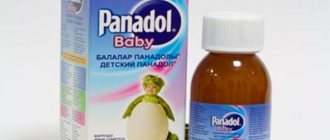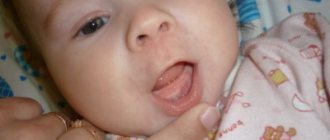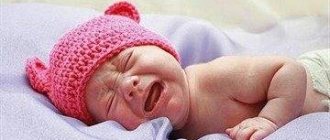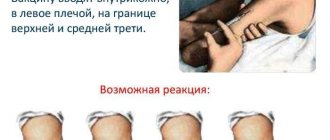When a child starts teething - a table of norms for parents
Any mother waits with trepidation for her baby’s baby teeth to start erupting. Symptoms of the imminent appearance of incisors can worry a newborn baby several months before they occur. It is necessary to know exactly the timing and order of teething in infants, because they will tell you about the correct development of the baby. Having noticed any deviations, you can solve all dental problems in a timely manner.
Baby is teething
Why do molars turn black in a 6 year old child?
When a 6-year-old child's molars turn black, parents begin to sound the alarm. Darkening of the enamel can occur even with good oral hygiene. When a child’s radical units turn black, the reasons may be the following:
- Incorrectly composed diet: excessive amounts of sweets, lack of meat and fish.
- Dysbacteriosis can also cause darkening of teeth.
- Hereditary factor.
- Deficiency of calcium and other microelements.
- Development of early caries.
The appearance of dark plaque is an alarming symptom that requires contacting a dentist. You should immediately seek help so as not to start the process.
general information
A newborn baby has to go through a lot in the first year of life: colic, gas, and teething. The schedule for the appearance of baby teeth in infants is individual; as a rule, the first incisor can be noticed only at six months.
Additional Information. The “dental” topic has a number of myths, one of which is that girls cut their teeth faster than boys. There is no medical support for this claim.
Rules for the appearance of teeth:
- In a baby they usually grow in pairs. If mom notices one incisor, then it is likely that the second “brother” will appear in a few days. Sometimes even 4 teeth are cut at the same time.
- Eruption first begins with the lower jaw. If the central incisors appear from below, then a “mirror image” will appear from above. Likewise with fangs and molars.
- There is a formula for calculating the number of teeth: age in months minus two. That is, at 6 months there are usually already two teeth, and at 24 months – all twenty.
Teething symptoms
The appearance of teeth is a natural physiological process. For the baby and the parent, it can cause great discomfort and stress on the body.
Symptoms:
- excessive salivation;
- lack or decrease in appetite, refusal of breast or formula milk;
- the baby tends to put everything in his mouth and gnaw, because the gums are unbearably itchy and swollen;
Baby puts fingers and toys into his mouth
- where a tooth will soon appear, the gums swell and turn red;
- the daily routine is disrupted, sleep becomes more intermittent;
- a capricious and irritable child due to pain.
In some cases, other symptoms may be added:
- increased body temperature (usually up to 37.5 degrees, not higher);
- rhinitis and cough, as salivation increases;
- stool changes (stool becomes somewhat thinner);
- Red rashes appear on the chin.
Help with teething
There is only a small group of children who experience teething completely painlessly, but many children still suffer to varying degrees from the pain that accompanies teething. About two months before the appearance of the first tooth, the child becomes whiny, capricious, his salivation increases, his appetite disappears, and restless sleep appears. This is because the teeth are already erupting inside the gums, and you may notice a slight swelling in your child's mouth where the eruption is occurring. At this time, the baby begins to feel pain or severe itching.
Suffering from pain, a child begins to behave restlessly and cry if he cannot be distracted and calmed by games, in which case special pain-relieving gels can help you; they contain anti-inflammatory and antiseptic components. But this gel can be used no more than three times a day, so try to use it in very extreme cases. When itching appears, the child will try to chew everything that can be put in his mouth, so do not scold your child for this behavior, but rather give him special teething toys. The surfaces of such toys have different irregularities, and this helps the child relieve the itching that appears.
Timing and sequence of teething
The pattern of tooth growth is very approximate, but it is still worth focusing on the following order:
- The first are the central incisors; dentists call them “ones.” From below - after they come out from above.
- Then - the lateral incisors, which, accordingly, bear their name “twos”.
- After that - the first molars - “fours”.
- Then come some of the most “difficult” teeth to feel: fangs, or “threes”.
- Finally, the “fives,” which are also called second molars.
Teething pattern
The process of the appearance of incisors is very individual; pediatricians and dentists, focusing on the average values of most children, rely on certain time periods for teething.
When a child starts teething, the table is a visual example for parents to observe all the changes in the process of teeth growth.
Baby teeth eruption time
| Name | Time averages (months) |
| Central incisors | Below - from 6 to 9, Above - from 7 to 10. |
| Lateral incisors | Above - from 9 to 11, Below - from 11 to 14. |
| First molars | Below - from 12 to 18, Above - from 13 to 20. |
| Fangs | Below - from 16 to 22, Above - from 17 to 23. |
| Second molars | Below - from 20 to 26, Above - from 26 to 33. |
Important! When the time comes for the baby teeth to fall out (at the age of 5-6 years), the order of growth of the molars is usually exactly the same as it was with the very first teeth.
Ways to relieve your baby's condition
A newborn baby may not react at all to teething. As a rule, children's mood changes dramatically - they become capricious, whiny, or hang on their chest for days, or completely refuse it.
The task of parents during this period is to alleviate the baby’s condition and make the whole process as painless as possible. This is possible through the use of special medical products that have a local anesthetic effect and prevent the development of an inflammatory or infectious process.
What medications can be used (after consultation with the pediatrician and dentist):
- Gels. These include “Baby Doctor. First teeth", "Kamistad", "Kholisan", "Kalgel".
Pain relieving gel "Kamistad"
- Dentinox droplets (the same company also produces gels).
- "Traumel S" - ointment for gums.
Additional Information. Today people often resort to homeopathy. It is also relevant when teething. You need to be careful with herbs and plants, despite the fact that they contain natural plant components. If a child is allergic, then homeopathic remedies can be very harmful.
Also, when teeth are being cut, various teethers and rubber toys have proven themselves well; some mothers give their children a nimbler with a piece of apple or a dryer.
Teethers can be of various shapes, made of baby-safe materials: rubber or plastic. In some cases, they are filled with a special liquid or gel so that they can be cooled in the refrigerator. Cold perfectly dulls pain in the gums.
Massaging the gums with special devices: a finger brush or a gauze pad is very popular. These are not only excellent massagers, but also oral care products that will cleanse the mucous membranes and teeth of dirt.
Problems that arise when molars erupt
Quite a lot of difficulties may arise during this period. The most serious ones can be identified:
- Absence of radical units. Adentia is a rare pathology caused by impaired mineralization. Another reason may be delayed bone growth. The problem is solved by prosthetics.
- Formation of caries. Since new teeth are always very vulnerable, caries can sometimes occur if not properly cared for.
Parents should pay close attention to oral hygiene during the period of eruption of molars. The two cases above require contacting a dentist.
Problems and deviations from the norm
The norms for teething in infants are the absence of complications and a delay in the appearance of incisors.
The most important problems that may occur:
- The tooth does not appear for a long time, or the sequence of eruption is incorrect;
- Decreased immunity and related ailments: ARVI, otitis media;
- Stomatitis, caries in newly emerging incisors;
- Pneumonia;
- Retropharyngeal abscess.
Non-carious dental damage - fluorosis
At the moment of teething, children experience aseptic (that is, “germ-free”) inflammation on the gums, which contributes to an increase in temperature, sleep disturbance, and changes in stool. This process can be caused by the development of an infection, its attachment, then septic inflammation occurs, which significantly complicates the process of teeth appearing.
Note! When choosing pain relief products, you should only use those that are intended for children. Recently, “Cholisal” has proven itself well, having a triple effect at once: it relieves pain, inflammation, and fights bacteria, viruses, and fungi. The gel is effective for a certain period.
Reasons for delayed tooth growth:
- Hereditary factor;
- Lack of calcium in the body, baby’s rickets;
- Lack of hormones produced by the thyroid gland;
- Impairments in the digestion and absorption of nutrients;
- No tooth buds – pathology;
- The baby was born premature;
- Advanced infectious disease.
A variant of the norm is considered if the baby’s baby teeth are located asymmetrically, with gaps between them. Subsequently, when the dentition begins to form, everything will level out. At 6-7 years old, when teeth change, gaps may form again. This is due to the fact that molars are slightly larger in size than baby teeth. Parents should not worry about this.
When teething, the baby's condition can deteriorate greatly. To avoid negative consequences, you should provide timely assistance, relieve pain with recommended medications and monitor the baby’s condition.
How to improve your child's condition
Pain in the teeth is not a pleasant symptom, which is difficult to deal with even for an adult. And it is much more difficult for children to endure toothache. The growth of molars may be accompanied by slight discomfort, as well as general weakness. Therefore, it is better to find out in advance when this period begins in order to help the child at any time. When a tooth erupts, it damages the lining of the gums. This causes slight inflammation. In such cases, dentists talk about an aseptic inflammatory process, which often causes fever and digestive disorders. Standard medications for the treatment of inflammation in the oral cavity are not all suitable for children. Doctors often prescribe Cholisal, which does a good job of eliminating pain and reducing inflammation. This drug also affects bacteria. Before use, be sure to consult a specialist. What else can help:
- Light gum massage.
- A cold compress can be applied several times a day.
- Using special gels with an analgesic effect: Metrogyl Denta, Kalgel. Use no more than four times a day is allowed.
- To eliminate fever, standard remedies are used that a child usually takes when the temperature rises. Carefully monitor how much medicine you give your child so as not to exceed the norm.
Pattern of tooth loss in children by age
Healthy teeth are not only a beautiful smile, but also an important condition for the health of the entire body. Therefore, it is important for parents to know how the change of baby teeth to permanent ones occurs, and whether everything is correct and on time for their children.
How teeth grow and change
We have 32 teeth. Four of them - “wisdom teeth” - erupt in adults, and even then not in everyone. Of the remaining 28 teeth, 20 first grow as milk teeth. Later, two more pairs grow on each jaw - immediately permanent.
How and why does this happen? Babies start to have their first teeth at about six months of age. The child is still very tiny, and his jaws are also small, which is why his baby teeth are so small.
Gradually, the child grows, the jaw bones grow, and the teeth begin to move apart, making room for larger permanent teeth.
Baby teeth have the same roots as permanent teeth. These roots begin to gradually dissolve, the teeth lose their support, wobble and finally fall out.
At what age do baby teeth begin to fall out?
Usually, a change in bite begins at about 6 years of age; this is considered the norm - most first-graders appear in school photographs at the most “spectacular” moment of changing their front teeth.
It is important to remember that children are all different, so the timing is very approximate. In recent years, experts have noted that increasingly, teeth begin to fall out as early as 5 years old - modern children develop faster.
You should be concerned if your child has not lost a single tooth by the age of 8. But this limit is conditional, it depends on many factors - heredity, what the child eats and, especially, what kind of water he drinks, what illness he had and how he was treated. Girls usually change teeth faster than boys.
The same is approximately the age at which children lose teeth. A complete replacement takes 5 to 8 years. Normally, all baby teeth should fall out by age 13-14.
Order of tooth loss
Let us remind you: teeth (incisors, canines, lateral molars) grow in a certain order. And they fall out too.
Table of timing of loss of baby teeth in children
| Name | Age |
| Central incisors | 5-7 years |
| Lateral incisors | 7-8 years |
| First (small) molars | 8-10 years |
| Fangs | 10-12 years |
| Second (large) molars | 11-13 years old |
Normally, children's teeth are replaced with permanent ones in the same sequence in which baby teeth erupt. The central incisors in the lower row usually fall out first, then in the upper.
Then comes the turn of the lateral incisors, and behind them the first (small) molars, “fours”.
Many parents, having noticed that teeth are changing “every other”, are worried about why this is not happening in order and at what age the child’s fangs fall out. There is no need to worry, the fangs will change in due time, at 10-12 years. These teeth are anatomically designed so that they change later.
The last to fall out are the second (large) molars - “fives”.
When teeth change: rules for children and parents
- As early as possible, teach your child to brush his teeth twice a day and rinse his mouth after each meal.
- The baby's diet should include foods rich in calcium - milk, kefir, cottage cheese, yoghurts, etc.
- Sweets in large quantities, hard caramels, nuts and crackers are always harmful, especially during the period of teeth change.
- There is no need to specifically loosen baby teeth, but it is also useless to forbid a child to do this - you still won’t keep track.
- Teach him to wash his hands thoroughly before putting them in his mouth.
- Apply a sterile swab to the wound at the site of the lost tooth; no need to treat with antiseptics.
- If the baby is in great pain, the gums are swollen, or the temperature has risen, consult a doctor immediately.
Possible problems when changing teeth
The pattern of tooth loss in a child given above is the average statistical norm. But children are different, and situations are different.
- If a tooth fell out earlier, but a new one quickly appeared in its place, everything is fine. But if a permanent tooth is in no hurry to grow, or a child accidentally knocks out a tooth, or for some reason it had to be removed, then neighboring teeth may begin to move in its direction. Then there will be no room left for the permanent tooth. This can lead to malocclusion, gum deformation, speech problems, etc. To prevent this problem, special holders are installed.
- If a permanent tooth does not grow in place of the milk tooth, there can be two main reasons: either for some reason it cannot erupt, or it is not formed at all. In any case, if a tooth is missing for more than three months, you need to consult a doctor - in modern dentistry there are no problems that cannot be solved.
- If a child is already 8 years old and his baby teeth are not falling out, this is also a reason to contact specialists, and not only dentists. The problem may be complex.
- If permanent teeth have already erupted, but baby teeth have not yet fallen out, and so-called “shark teeth” have formed, there is no need to worry. All the same, over time, the milk will fall out and the dentition will level out. But if this process lasts up to three months, then the baby teeth must be removed. In any case, it will be better if the process is supervised by a doctor.
Let's sum it up
Changing teeth from milk teeth to permanent ones is the most important period: your child will live with this set for the rest of his life.
There are periods for the loss of baby teeth that are considered the norm, but these are the rules, and life is full of exceptions.
Teach your child to take care of their teeth and visit the dentist regularly.
Teeth in children 5-6 years old
Parents often ask: how many teeth does a child have at 5 years old? Normally there are 20 baby teeth, which should all be replaced by permanent teeth, normally up to 12 years of age. Here is the answer to another frequently asked question: what kind of teeth do children change? Please note once again - all baby teeth fall out and are replaced with permanent ones!
And those 6th molars that erupt after 5 years of age, and which most parents consider to be milk teeth, are the FIRST PERMANENT TEETH ! We deliberately highlighted this information in large font, because many parents think that these are delayed baby teeth and simply miss their list of what requires close attention. And when, at the age of 8-9, it turns out that these PERMANENT TEETH have already been eaten away by caries, it will be too late to regret. Here, without the desire to once again advertise ourselves, we once again invite the obligation of constant dental monitoring of the child, preferably with one doctor (this is generally ideal), from a very early age. Let it be at least a pediatrician (but qualified and regularly!), let it be a district dentist, or specialists from the Utkinzub dental clinic.
Read also: Teeth in children under one year old
We offer you constant and qualified supervision of your child almost from the moment of birth until adulthood. In this case, our clinic guarantees a timely, highly effective modern response to all kinds of problems that arise during the growth of your child, treatment at the very initial stages of diseases or various pathological conditions, including injuries to which adolescents are often susceptible, as well as emergency dental medical assistance. Or qualified consultations on all issues that concern you.
Temporary teeth
Timing of teething
Dental buds are formed during the period of intrauterine development. The eruption of the first teeth begins at the twenty-fifth week of the baby’s life. The lower incisors appear first, followed by the upper ones by eight months. The age at which baby teeth, called premolars, erupt varies from one to two years. The last to appear are the canines and second premolars, which occurs from sixteen to thirty months.
This teething schedule is optimal, but it is impossible to determine the exact timing. The process depends on the characteristics of the child’s body, the health of the mother during pregnancy and genetic factors.
Timing of teething in children in the table
| Type of tooth | Lower jaw | Upper jaw |
| Medial incisor | 6 – 10 months | 7 – 12 months |
| Lateral incisor | 7 – 16 months | 9 – 13 months |
| Fang | 16 – 23 months | 16 – 22 months |
| First premolar (baby molar) | 12 – 18 months | 13 – 19 months |
| Second premolar (baby molar) | 20 – 31 months | 25 – 33 months |
The order of teething in children
The teeth follow the principle of pairing, for example, if one fang appears, a second one should be expected soon. The sequence of teething is determined by nature based on the practical significance of dental units for survival.
The front teeth of the lower row grow first, then the upper ones come. The lateral incisors disrupt the order of teeth eruption; their appearance begins with the upper jaw. Then comes the eruption of chewing teeth - the first premolars. The last to emerge are the canines and molars. The process of teething in children is completed by the age of 2-3 years.
Diagram of baby teeth eruption in children
Permanent teeth
Timing of teething in children
The first permanent teeth appear several months before the baby teeth fall out—the molars, or “sixes,” erupt. This occurs at the age of six. By the age of eight or nine years, it is the turn of the incisors. When a child is ten to twelve years old, premolars and canines erupt. Next come the second molars, the eruption of molars is completed by adulthood.
Wisdom teeth appear much later, after twenty years. However, their complete absence is also the norm.
Timing of teething in the table
| Name | Lower jaw - time of eruption | Upper jaw - eruption time |
| Medial incisor | 6 - 7 years | 7 - 8 years |
| Lateral incisor | 7 - 8 years | 8 - 9 years |
| Fang | 9 - 10 years | 11 - 12 years |
| First premolar | 10 - 12 years | 10 - 11 years |
| Second premolar | 11 - 12 years | 11 - 12 years |
| First molar | 6 - 7 years | 6 - 7 years |
| Second molar | 11 – 13 years | 12 - 13 years old |
| Third molar | 17 – 21 years old | 17 – 21 years old |
Teething order
The pairing principle also applies to permanent dental units. The correct sequence of teething is important for the formation of the bite; it is necessary to carefully monitor the time of loss of baby teeth and the order of growth of molars.
The lower molars appear first, then the upper ones. Next, the temporary teeth of the lower jaw fall out, the permanent teeth erupt, and only then the upper dental units are replaced.
This schedule for teething in children is not universal, but if there are significant deviations, you should consult a specialist.
How many teeth should a child of 5 years and older have? Do they still have milk teeth?
In five-year-old children, after a two to three year period of stability, the transitional process of formation of the dental system begins.
New, larger teeth are erupting, and the old ones that the child is accustomed to are becoming loose. The body is preparing to replace the first baby teeth with adult teeth. A bite begins to form.
During this period, mothers need to be attentive to the condition of the child’s dental system and regularly show the baby to the dentist.
At what age does the eruption of baby teeth end?
Young children teethe individually. There are situations when the front incisors emerge as early as 4 months. In general, long-term observations show a pattern of filling the dentition in children.
To find out the normal number of teeth a baby has, you need to use the formula. We subtract the number 4 from the age in months and find out how many units a child can erupt. For example, he is 10 months old. We calculate according to the formula. 10 – 4 = 6. Thus, at 10 months the baby is supposed to have 6 teeth. The table below shows the average time during which children erupt their first teeth.
| Pair number | Which jaw? | Name | How many months |
| 1 | Lower | Central incisors | 6 — 7 |
| 2 | Upper | Central incisors | 8 — 9 |
| 3 | Upper | Lateral incisors | 9 — 11 |
| 4 | Lower | Lateral incisors | 11 — 13 |
| 5 | Upper | Primary small molars | 12 — 15 |
| 6 | Lower | Primary small molars | 13 — 15 |
| 7 | Upper | Fangs | 16 — 18 |
| 8 | Lower | Fangs | 18 — 20 |
| 9 | Lower | Large molars | 24 — 30 |
| 10 | Upper | Large molars | 24 — 30 |
The table shows that the formation of the dentition is completed at 30 months. Thus, at the age of two and a half years, a healthy child has 20 teeth. A delay of up to six months is considered normal. Moms don't need to worry just yet. If the schedule violation exceeds 6 months, then you should visit a pediatric dentist.
READ ALSO: How to help a child when he is teething?
How many teeth should a child have at 5 years old?
In five-year-old children, the entire milk series of 20 units has been formed. If by this time the composition is not complete, it is necessary to urgently show the child to the dentist.
After 5 years, active growth of the rudiments of permanent teeth occurs and the replacement of milk teeth begins (for more details, see the article: at what age do a child’s milk teeth begin to fall out?). New teeth “push” the old ones from below, the roots dissolve.
Baby teeth become loose and are preparing to fall out (we recommend reading: when do children lose baby teeth and how many permanent teeth should an adult have?).
In addition, at this age, behind the entire dentition, in the place where there were unfilled areas, permanent chewing molars - “sixes” - erupt. This process is painless and lasts up to 6 or 7 years.
Some parents mistakenly consider them milky and believe that they too will fall out. However, in humans, twelve units of the dentition are irreplaceable, that is, they immediately grow permanent.
Thus, a five-year-old child may have between 20 and 24 teeth.
When and how do baby teeth change to permanent ones?
Starting from the age of six, the milk line is replaced by a permanent one. Replacement occurs in the same sequence in which baby teeth erupted. This process stretches from 6-8 to 13 years, but the formation of the jaws does not end there. Following the loss of milk, the following are cut:
- No later than 14 years - second large molars (“sevens”) (we recommend reading: differences between baby teeth in children and molars).
- From 15 years and older - third molars, “eights” or “wisdom teeth” (in some people they appear before the age of 30 or do not erupt at all). The table shows the replacement periods for baby teeth.
| Which jaw? | Which permanent ones erupt? | Age, years (boys) | Age, years (girls) |
| Lower | Central incisors | 6-7 | 6-7 |
| Upper | Central incisors | 7-8 | 7-8 |
| Upper | Lateral incisors | 8-9 | 8-9 |
| Lower | Lateral incisors | 7-8 | 7-8 |
| Upper | First premolars | 8.5-11 years | 8-10 years |
| Lower | First premolars | 9-12 years | 8.5-12 years |
| Upper | Fangs | Up to 12 years | Up to 12 years |
| Lower | Fangs | 9-11 | 9-10 |
| Lower | Second premolars | 10.5-13.0 years | 10-12,5 |
| Upper | Second premolars | 10.5-13.0 years | 10,5-12,5 |
Parents' actions after tooth loss
Before falling out, the baby tooth is loose, so its loss usually does not bother the child (for more details, see the article: table with the timing of teething in children). Parents should be prepared for such a moment and do the following in the event of a loss:
- a sterile swab should be applied to the wound that formed at the site of the lost tooth to stop the bleeding;
- You should not feed the baby for 2 hours after the loss;
- within 2-3 days, the child’s food should be warm and uniform in consistency, without solid particles;
- After each meal you should rinse your mouth;
- the plug of coagulated blood that forms at the site of the wound cannot be removed, it will come out on its own;
- the hole should not be treated with antiseptics, especially hydrogen peroxide;
- The child should be explained that the wound should not be touched with fingers;
- If the temperature rises after the loss, you should immediately consult a doctor.
Caring for baby's baby and permanent teeth
Parents should be very attentive to the condition of the child’s oral cavity during the period when teeth are falling out and cutting. Under no circumstances should you try to pull out a loose tooth yourself. You should visit the dentist at least twice a year.
The rules for caring for a child’s oral cavity are as follows:
- Periodically examine the baby's mouth. Any darkening of the teeth or swelling of the gums is a reason to visit a doctor.
- Pay close attention to how your child eats. If your baby tries to eat with only one side of his mouth, then this should be alarming.
- Teaching the child how to properly clean the mouth with a toothbrush and explaining that this procedure is mandatory. You need to cleanse twice a day - morning and evening. Buy your child “delicious” children’s toothpastes and change brushes every three months.
- After every meal you need to rinse your mouth.
- Food products must contain all the necessary vitamins and microelements, and the amount of sugar should be controlled.
Pathologies of teething and dental diseases in children over 5 years of age
With the growth and development of the jaw, by the age of five, the child develops interdental spaces - trema. This is a normal physiological process. They are needed to properly position larger permanent teeth.
Sometimes the cracks do not appear, or their size is insufficient. Then there is a risk that the dentition will be crooked. The absence of interdental spaces in a 6-year-old child should worry his parents. The child needs to be shown to a doctor.
Children under 4 years old sometimes get their baby teeth knocked out while playing. A permanent one will not immediately grow in its place. Prolonged emptiness can negatively affect adjacent units of the dentition. They may begin to move forward or sink. A timely visit to an orthodontist will help solve this problem. The doctor will install a temporary replacement structure in place of the lost element.
The doctor also monitors the development of the jaws and the correctness of their closure. The bite is formed starting from 9-11 years of age. Parents usually do not notice any abnormalities. Early start of bite correction is optimal at the age of 10 years. Orthodontic treatment at this time is the most painless, fast and effective.
As a rule, permanent units appear in children within the time periods described above (for more details, see the article: when do children get molars?). There are delays in eruption. If the deviation from the norm is more than six months, then a consultation with a dentist is necessary. The reasons for significant violations may be the following:
- individual hereditary characteristics;
- weakened immune system;
- presence of chronic diseases;
- deficiency of calcium, vitamins and other elements.
Source: https://pro-zuby.com/deti/detskie-zuby/skolko-zubov-u-rebenka-v-6-let.html
Signs of teething
Symptoms of teething in infants
The appearance of baby teeth is a little more difficult than that of permanent teeth, since the baby has not yet encountered pain and cannot understand what is happening to him. Teething in children under one year of age is accompanied by the following signs.
- The most common symptom of teething is fever. An increase to 38 degrees within three days is normal.
- Swelling of the gums. Often, when children are teething, their gums swell, their sockets itch, and they have a desire to chew hard objects. It is important to prevent the child from damaging the mucous membrane; it is better to buy a special teether to relieve discomfort.
- Decreased appetite. Children refuse to eat due to stress or itchy gums.
- Teething syndrome. Neurosis, tearfulness, anxiety, poor sleep and whims may indicate the imminent appearance of the first tooth, even if the child does not experience pain, fever or swelling of the gums.
An increase in white blood cell levels during teething should not be a cause for alarm. This is a common occurrence associated with a weakened immune system.
Symptoms of eruption of permanent teeth
A change in temporary bite is accompanied by other unpleasant sensations. The process has the following characteristics.
- Root resorption and loss of baby teeth. A sure signal of the appearance of a new tooth in the coming months.
- Increase in jaw bone size. Permanent teeth are larger than baby teeth, the jaw grows, creating conditions for a change in bite.
- Pain in the gums. Redness and swelling of the mucous membrane are a reaction to teething.
Body temperature above 38 degrees, cramps, refusal to eat and difficulty breathing are not symptoms of the appearance of milk and permanent teeth. These are signs of an infectious disease. It is necessary to urgently consult a doctor.
Which teeth hurt more when teething?
Some children experience the eruption of fangs very painfully, and eruption also occurs with anxiety when fours and fives appear. The teeth, coming out with their sharp edges, cut through the baby’s gum tissue, and therefore the child begins to be capricious and experiences discomfort when the gums begin to swell. The teething itself in a child occurs depending on his genetic parameters and biological age.
It is worth knowing that when the gums swell, a child may experience pain not only in the exact place where the tooth erupts, but in the entire mouth. A tooth may appear within a month, or maybe after two months it will not even appear on the surface of the gum. These are all individual characteristics of your baby, and you should not be upset if, with constantly inflamed gums and increased salivation for more than a month, teeth have not appeared. A child under three years old should have 20 teeth, and their eruption can occur in different ways, so you should not find out which teeth erupted painfully in other children.
Read also: Stomatitis on the tongue treatment in children
Painful teething: advice for parents
When faced with teething in children, many parents are at a loss. First of all, you need to call an ambulance and determine the reason for the baby’s poor health. If symptoms are confirmed, the specialist will prescribe medications for teething - antipyretics and painkillers.
You can treat your gums yourself with an anesthetic gel with a cooling effect to reduce itching and swelling of the mucous membrane. Ice will also help. To reduce gum irritation, there are special silicone fingertips made of hypoallergenic material.
Folk remedies for teething will effectively relieve painful sensations - a decoction of chamomile, sage, tincture of valerian and honey will soothe inflamed tissues.
Painkillers for teething are contraindicated in children; this can worsen their health.
Without a doctor's recommendation, antibiotics and other strong teething medications can cause an allergic reaction.
Oral care during molar growth
Parents should accustom their children to competent and proper care as early as possible. By the period of growth of the radical units, the child should be able to independently use a brush and paste. Other recommendations must also be followed:
- Use hygiene products that are optimal for the child. You can consult your pediatrician about the choice of toothpaste and brush.
- Limit the consumption of sweets and sweet soda, as all this leads to the development of caries. When permanent units are cut, they are very vulnerable, so carious lesions can form within a few weeks.
- Children's diets must include dairy products, meat and fish, fruits and vegetables.
- Rough food should also be present in the diet. Thanks to it, the growth of hard tissues improves.
- A child should be shown to the dentist for the first time before the age of three. When the first molars are cut, the baby should be ready to visit the doctor without fear.
It is necessary to be attentive and responsible about the health of children's molars. Failure to follow basic rules can lead to serious consequences.
Deviations in teething
Minor changes in the timing and sequence of dental growth should not cause alarm. However, significant deviations from the norm in teething are a cause for concern.
- The tooth does not appear for a long time. Reason: genetic predisposition to long eruption or lack of rudiments.
- Too early appearance of teeth. Caused by disruption of the endocrine system.
- Black or brown enamel surface color. Indicates high iron levels, poor salivation, or chronic inflammatory processes in the child’s body.
- Incorrect row position. Bite pathologies indicate a hereditary factor or deformation of the maxillofacial bone.
FAQ
The period of teething causes concern not only for children, but also for parents. Startsmile has compiled a list of the most popular questions on this topic.
Question:
How long does teething take?
Answer:
From two to six days.
Question:
How long do unpleasant symptoms last during teething?
Answer:
Discomfort is felt for two to three days before the onset and about three days after.
Question:
What to do when teething?
Answer:
Don’t panic, calm the baby down, surround him with attention and care.
If necessary, call a doctor. Question:
What to give when teething?
Answer:
Soothing decoctions, frozen fruits and medications prescribed by a specialist.
Question:
Is it possible to get vaccinations during teething?
Answer:
No, if the immune system is weakened, the procedure will lead to complications.
When do baby teeth change?
Milk teeth got their name thanks to the ancient Greek physician Hippocrates, who was convinced that they are formed from mother’s milk. Did you know that baby teeth don’t always change? In the absence of the rudiments of permanent crowns, a person can live with milk teeth all his life, right up to old age.
When should teeth normally change, what does this process depend on, what deviations can occur, and how to prevent them - read our article.
Timing of change of baby teeth
Factors influencing timing:
- Heredity. Very often children change teeth at the same time as their parents did in childhood.
- previous infections;
- metabolic problems. Metabolic disorders occur due to rickets, phenylketonuria and other diseases affecting metabolic processes;
- dyspepsia – disturbances in the functioning of the stomach;
- absence of rudiments of molars. Such pathologies arise in the prenatal period due to pathologies during pregnancy.
Symptoms of eruption of molars
The following symptoms will indicate an imminent change in bite:
- Interdental spaces increase. This indicates that the jaw bone is growing and will soon have plenty of room for molars.
- Baby teeth lose stability and begin to loosen. This is due to the fact that the process of constant growth has begun under the milk units.
- If a baby tooth has fallen out, this will also indicate that the molar will soon begin to appear.
- Swollen, slightly reddened gums. During this period, you should be especially careful about proper oral hygiene, otherwise a fistula may form.
- When teething, children often have a runny nose, the discharge is clear, and there are no symptoms of colds or acute respiratory viral infections.
- Salivation may increase.
- General malaise and weakness are also normal.
- In some cases, parents notice disturbances in the functioning of the digestive system. The problems are caused primarily by the fact that the child’s nutrition is disrupted due to discomfort in the oral cavity.
Most of the listed signs appear when a 6-year-old child begins to erupt molars.
How baby teeth are replaced with permanent teeth
When baby teeth change, their roots begin to gradually dissolve, giving way to new ones.
How does this mechanism start?
- All permanent tooth buds are separated from the deciduous roots by a bone plate. When the molar tooth germ begins to develop and increase in size, it puts pressure on the bone plate.
- During this process, osteoclasts appear - cells that dissolve the mineral component of the bone.
- In parallel with the “attack” of osteoclasts from the outside, the tooth experiences internal changes: its pulp (neurovascular tissue) changes and turns into granulation tissue, which also contains osteoclasts.
- Thus, the milky roots are exposed to osteoclasts from the outside and inside and are resorbed.
- There is only one crown left: it begins to wobble and soon falls off, because it simply has nothing to hold onto the jaw.
Often this process is accompanied by an increase in body temperature and general malaise. When a tooth “comes off” from the row, slight bleeding is observed. Normally it stops after 3-5 minutes.
Growth of radical units before the loss of milk
Normally, permanent teeth begin to grow, loosening baby teeth. But sometimes pathologies arise. If there are all signs of eruption, but the baby tooth is not loosened enough, under no circumstances should you pull it out yourself. Delayed loss of the first teeth can cause the following complications:
- The molar will grow incorrectly. Sometimes a permanent tooth begins to grow in a different direction because the missing baby tooth prevents it from coming out normally. Incorrect growth of molars can cause curvature of the entire row.
- The tooth itself may grow crooked. Even before the moment of eruption, the molar or incisor becomes strongly curved. In such situations, the child should be shown to a pediatric dentist.
- As the gums become slightly swollen and red, a fistula may form in the inflamed area.
Incorrect growth of a permanent tooth can only be corrected by a specialist.
The order of changing teeth
- The central incisors are the first to fall out, at the age of six or seven.
- At seven or eight years of age, it is the turn of the lateral incisors.
- From nine to eleven years - the first molars, from nine to twelve - the lower canines.
- Later than everyone else - from ten to twelve years - the upper canines, first and second molars of both jaws fall out.
For most children, the process of replacing baby teeth with molars takes five to six years and lasts until the age of thirteen or fifteen.
FAQ
Do all 20 baby teeth change?
Absolutely everything must change. If some of them have not been replaced with radical ones, you need to see a dentist.
How to help a child with loss of baby teeth?
It is important to provide your baby with adequate nutrition: include foods rich in calcium, vitamin D, fluoride, fresh vegetables and fruits. It is also recommended to exclude sweets as much as possible. Great importance should be attached to oral hygiene (ideally brushing after every meal).
If there is bleeding at the site of a lost tooth, the child should be given a sterile cotton or gauze swab to bite on.
When is dental help needed?
You cannot do without consultation or professional help from a dentist if:
- there is increased swelling and pain in the gums;
- The molars have already appeared, but the “temporary” ones have not yet fallen out. They need to be removed, otherwise the permanent ones will grow crookedly;
- the milk ones have fallen out, but the radical ones have not yet appeared. In such cases, they may cut through crookedly.
What to do if your teeth grow crooked?
Make an appointment with an orthodontist and begin treatment. Malocclusion is corrected with plates, braces, and trainers.










